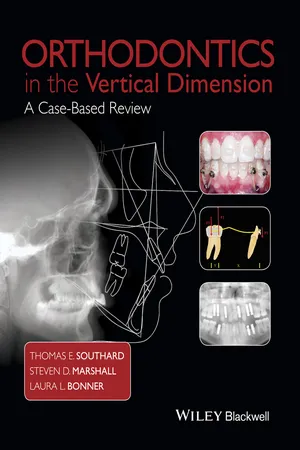
Orthodontics in the Vertical Dimension
A Case-Based Review
- English
- ePUB (mobile friendly)
- Available on iOS & Android
Orthodontics in the Vertical Dimension
A Case-Based Review
About this book
This case-based clinical text is an exhaustive review of orthodontic problems in the vertical dimension, with evidence-based guidelines for successful diagnosis and treatment. A total of 21 cases address dental deep bites, skeletal deep bites, dental open bites, skeletal open bites, and posterior open bites. Each case includes pretreatment, interim, and posttreatment orthodontic records, as well as references to provide a solid evidence base for decision making. Written with a clinical focus, Orthodontics in the Vertical Dimension is ideal for the practicing orthodontist and makes an excellent resource for residents in pursuit of board certification.
Key Features
• Detailed case-based scenarios for treatment of the spectrum of open bites and deep bites
• Cases presented in question and answer format to encourage thought
• 2500 clinical photographs and illustrations.
"This is a great textbook, and I will use it in my classes. Highly organized and elaborately illustrated, the authors' work is inspired by problem-based learning and stimulates cognitive processes by encouraging critical thinking. Their text deserves a 'must read' category for orthodontic professionals of all ages."
Dr. Jeryl D. English DDS, MS, Chairman and Graduate Program Director, Department of Orthodontics, The University of Texas Health Science Center at Houston
"A terrific book for students of orthodontics and dentofacial orthopedics, covering the vertical dimension and much more. A wide range of cases are presented, treatment plans are realistic, and the authors openly discuss complications encountered during treatment."
Dr. Greg J. Huang, DMD, MSD, MPH Professor and Chair Department of Orthodontics, The University of Washington School of Dentistry
"This comprehensive text prepares the reader in the context of a mini-residency with a question answer teaching style. Resident and experienced orthodontists can match their cases with fully worked up patients and alternative treatment options. Well written."
Dr. Katherine L. Vig, BDS, MS, FDS, D.Orth Professor Emeritus and Former Head of Orthodontics, The Ohio State University College of Dentistry
Frequently asked questions
- Essential is ideal for learners and professionals who enjoy exploring a wide range of subjects. Access the Essential Library with 800,000+ trusted titles and best-sellers across business, personal growth, and the humanities. Includes unlimited reading time and Standard Read Aloud voice.
- Complete: Perfect for advanced learners and researchers needing full, unrestricted access. Unlock 1.4M+ books across hundreds of subjects, including academic and specialized titles. The Complete Plan also includes advanced features like Premium Read Aloud and Research Assistant.
Please note we cannot support devices running on iOS 13 and Android 7 or earlier. Learn more about using the app.
Information
CHAPTER 1
Foundations
The Spectrum of Vertical


Table of contents
- Cover
- Title page
- Table of Contents
- Preface
- CHAPTER 1: Foundations
- CHAPTER 2: Dental Deep Bites
- CHAPTER 3: Skeletal Deep Bites
- CHAPTER 4: Dental Anterior Open Bites
- CHAPTER 5: Skeletal Anterior Open Bites
- CHAPTER 6: Posterior Open Bites
- APPENDIX
- Index
- End User License Agreement